I have a weakness for free chairs. Here’s a bar stool that Brian and I found while taking a walk.
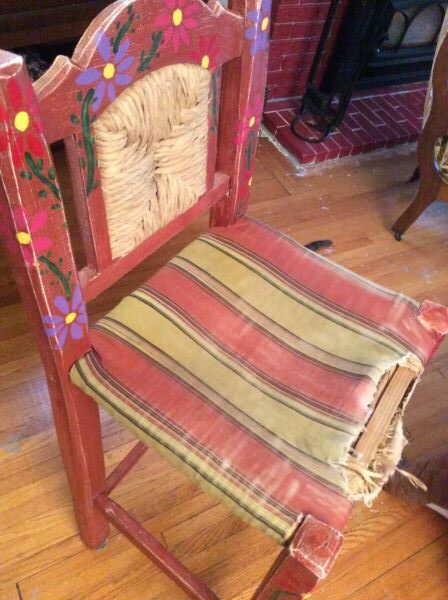
I imagine a student made this chair in shop class back when there were industrial arts in high school. Or someone — a man who was born knowing how to use a table saw — took an afternoon to make the chair in his garage. It was raining that day, and he was trying to escape the house where his wife was hosting a party for a recently divorced friend. Whatever its origins, a chair like this should be part of a set but I doubt it ever was.
In the city, leaving an item on the curb is a common way to pass it on. But I still look around for permission before taking anything. “Is this broken, hideous chair that’s sitting next a toilet and a dumpster full of construction debris free? Amazing!”
Wanting to give the chair a chance, the woman I spoke to had moved it from the alley to a prominent corner. Picturing this made me think of ants who are always busy moving material of various sorts: an errant crumb, the foundation of my house. This woman and I must be some kind of recycling ants. Her job is to unearth treasures and put the bright shiny things on the main trails where other roving ants like me will see them, whereupon they will enlist a stronger ant to carry the item for several blocks back to the nest.
Upon a closer look, I might have reneged on taking the chair. But seeing how my initial interest had perked up the ant-woman who was invested by this point, my obligation was clear. Or it could have been that it was the height of the pandemic, and fixing junk replaced recording interviews for my podcast. Or maybe it was my age that compelled me to take the chair. I can still hear my neighbor who is a little older than me say, “I also went through a chair phase,” while another friend joked that I was one step away from glazing a bowl in a shop window.
As expected, my cats claimed the bar stool. We’re not keeping it. So, don’t get too attached, Bert.
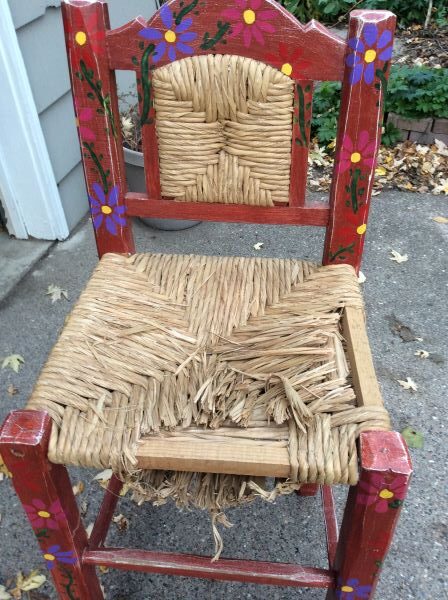
I brought the chair to the cat-free garage and started to investigate. This is the first step to fixing anything. It’s interesting to see what the ants before me did to beautify the piece. In this case, fabric covered a worn-out rush seat, proving that we do what we know how to do. In this case, someone knew how to use a staple gun. Was the fabric chosen or was it just handy? The flowers that are painted on the frame were also someone’s idea of an upgrade. They were supposed to cheer up the place or camouflage an objectionable shade of brown. Regardless, it was a job to remove it.
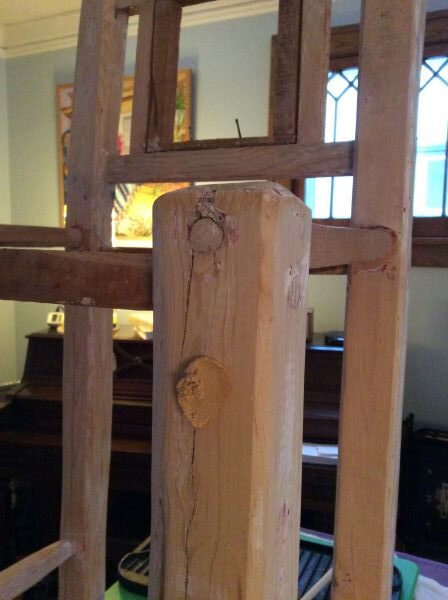
Once I stripped the chair, it became clear that whitewashing it (a technique I saw on YouTube) would not produce the desired effect. Though the joints were tight (Thank goodness! I wouldn’t need to “Take it apart and glue it back together again,” as one of my favorite YouTubers is always saying), the wood was cracked and mismatched and generally in rough shape. My neighbor suggested painting it red and that sounded good.

Unable to find the right shade of red, I considered black. Brian was against it, saying that a chair like this needed the advantage of a pop of color. So, I stuck with my plan, which meant watching more YouTube videos about how to weave a rush seat. Then one day I woke up thinking about a checkered pattern. When my neighbor (the same who suggested the red) independently suggested checkers for the seat, I had to try it.
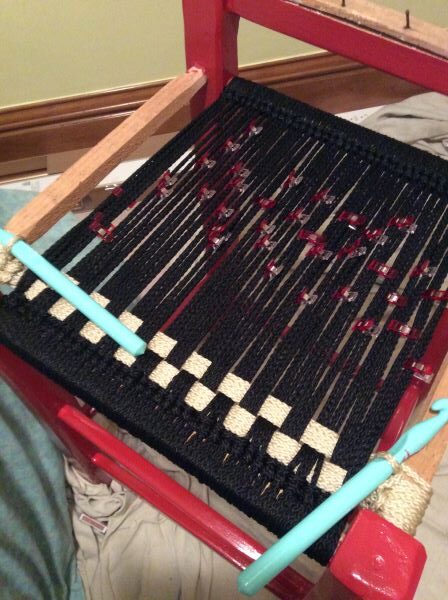
The checkers could have been bigger, and the improvement might have outweighed the cost of a weaker seat. But it was hard to justify starting over. Maybe I was being lazy. But there is something to be said for being done. However, even though I didn’t plan to keep this chair, I wanted to love it. I wanted it to be something I could sell or proudly give away. I wanted it to be state-fair-ribbon worthy. This was falling short of that fantasy.

Sometimes a project does not give a person satisfaction. Again, I wonder if I should have gone with a black frame. Again, Brian says no. Maybe finishing the back support would help? It did not. The black cross is accidental, something I’m always explaining. It reminds me of the God’s eyes we used to make in elementary school. I wouldn’t be surprised if there’s one in the things my mother returned to me — old report cards, yearbooks, etc. — some years ago.
As I worked on the chair, the cats persisted in claiming it, especially Bert. So, I surrendered to the idea and eventually quit scolding him for scratching on it, which he loves to do. “At least let me take a few pictures before you destroy it, Bert.” Fully embracing the idea that this was cat furniture that I was making, I wove a box to the bottom rungs of the bar stool because Michael and Bert love a box. It was also a chance to experiment with using cut up old socks (pieces are cut into loops and woven like how many of us made potholders as kids). It would not have been suitable to support the weight of a person (Yes, I wanted to try using old socks to refurbish a lawn chair. Fortunately I’ve been convinced that it would be a waste of time.). However, the socks work great to make a box or a hammock for a cat, assuming you can tolerate the shedding (of the socks, though cats shed too).
To assure me that my efforts would be worth it, both cats would sit on the chair while I was weaving it. Michael and Bert like to be involved in projects.

Here’s Michael sitting in the finished box.
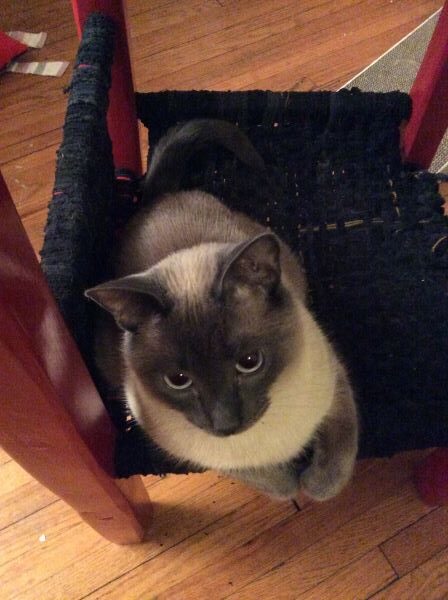
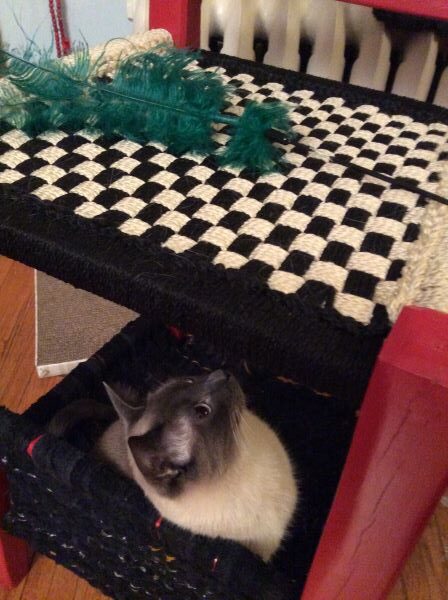
The cats do love this chair, especially when you mix it with playtime.

Here’s Bert on his highchair with a pad that my sister Amy crocheted using bits and bobs from her yarn closet.
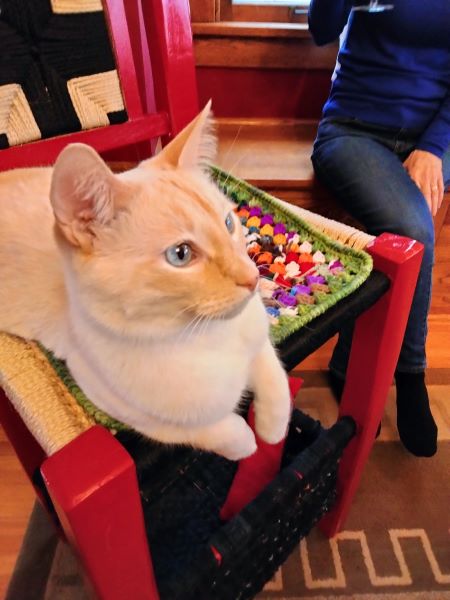
Though sturdy, this chair had its limitations. Or maybe I lack the imagination and the skill to make it the best that it can be. But I liked how the project evolved. And I like that it is done. And I love how Michael and Bert have given the chair its purpose. Down the road, an ant will look at this chair and say, “That red is terrible! Was it chosen or was it just handy?” She will wonder, “Is that supposed to be a magazine rack on the bottom?” and declare, “Poor chair!” She will drag it home. Take it apart and put it back together again. And think, “Surely, we can do better than this!”